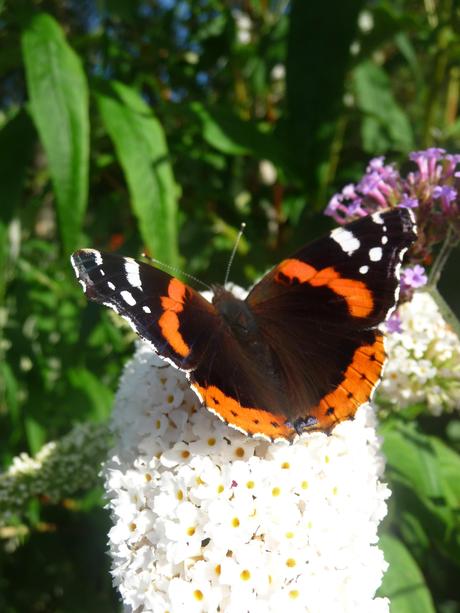 Red Admiral on BuddlejaAs I predicted, the lengthy dry spell has brought butterflies to the garden in greater numbers over the last few days. Airspace around the white Buddleja which has just started to flower is quite crowded at times – as well as butterflies and bees, we have seen Hummingbird Hawk Moths which I find fascinating to watch! The cat, Oscar lies on the patio trying to stay cool in the heat, but manages to stir himself to bat at passing butterflies if he considers them to be flying too close to him and at a tempting height!
Red Admiral on BuddlejaAs I predicted, the lengthy dry spell has brought butterflies to the garden in greater numbers over the last few days. Airspace around the white Buddleja which has just started to flower is quite crowded at times – as well as butterflies and bees, we have seen Hummingbird Hawk Moths which I find fascinating to watch! The cat, Oscar lies on the patio trying to stay cool in the heat, but manages to stir himself to bat at passing butterflies if he considers them to be flying too close to him and at a tempting height!
Dahlias of course are a favorite with bees who nuzzle into the fluffy, golden centres; the single flowers are much easier for insects to navigate and more nectar rich than double forms. We have various Lenten Roses (Helleborus) in the garden, with open flowers and nectar rich centres, providing valuable pollen in late winter and early spring, but the double forms are never visited – they hold little nectar and are too difficult to clamber into! Pulmonarias are another favorite with early bumble bees and begin to flower in January if it is mild, reminding me that it is important to provide ‘food plants’ for insects throughout the year.
Anything with a Foxglove type flower is always busy with bees. Perhaps this is why the wild Foxgloves do so well – they always seem to be loaded with fertile seed capsules once the flowers drop and bees certainly love them! Penstemon are in the same ‘Foxglove’ family and have showy flowers often with contrasting ‘bee lines’ to guide the insects in to do the work of fertilization when the pollen carried on their backs rubs off onto a different flower. I keep these deadheaded regularly to ensure a long flowering season but it would be interesting to raise some seedlings and see the results!
Our shrubby Abelia ‘Francis Mason’ is another plant with tubular flowers and a sweet scent that is loved by bees. The plant in our garden is a ball of glossy golden leaves and the tiny red buds are just appearing – ready to smother the plant in flowers from August until well into the autumn.
Later on in autumn and through the winter months, Viburnum tinus with its flat heads of white flowers is a favorite not only of Mrs McGregor for her arrangements, but any bees that may be on the wing. The Christmas Box (Sarcococca) which we have planted in a shady spot is also valuable to insects as well as providing the sweetest of scents on warm, still days.
Plants always jostle for space in our garden but I could plant a few more climbers. The Japanese Honeysuckle has made a tight screen after the drastic pruning that it received in spring and is covering a trellis with scented yellow flowers visited by hoverflies, bees and the Hummingbird Hawk Moth. At night, the scent from this and the Honeysuckles planted on the fence in the front garden, lies heavy in the air and is food for other moths which run the gauntlet of bats!
After some research, I have decided to purchase an evergreen winter flowering Clematis. Once the plant is established, it will flower from October to January, adding interest for us and also food for bees and other insects brave enough to venture out through the darker months!
